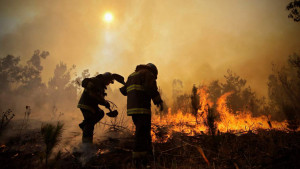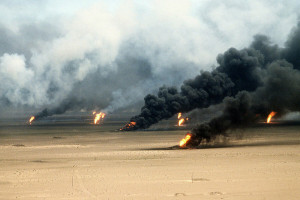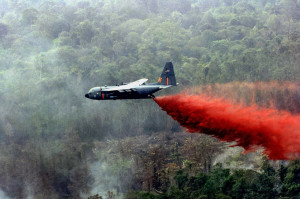ECOLOGICAL PROBLEMS OF THE ARMED FORCES ACTIVITIES
 An essential component of the national security system is also environmental security, the protection of vital human interests, first and foremost the right to live in a clean, healthy, environmentally friendly environment.
An essential component of the national security system is also environmental security, the protection of vital human interests, first and foremost the right to live in a clean, healthy, environmentally friendly environment.
A special place in the ecological security system is occupied by the issue of ensuring the ecological security of the Armed Forces, which is studied by military ecology. This field of general ecology studies armed struggle, non-military means and means of struggle, military facilities, the armed forces as a whole, and the environment. The subject of military ecology research is the interaction between the activities of the armed forces and the environment.
The activities of the RA Armed Forces include:
- Daily activities of troops (forces),
- mobilization volume;
- Conducting combat operations.
The daily activities of the troops (forces) include training, military-technical-economic-household activities. It is a permanent, real ecological danger of polluting the environment with chemical, biological, radioactive substances, various physical rays (infrared, ultraviolet radio waves, etc.).
The principle of giving priority to the protection of the health and life of the personnel, civil servants and the population must be observed in the daily activities of the troops. Its implementation can be achieved through the prevention of environmental pollution, regulated requirements of armaments and military equipment (SRT), control of compliance with the requirements of SRT environmental safety norms,, elimination of the effects of environmental pollution.
There are many possible sources of environmental pollution in a military facility. One of them is “organized” sources that have special equipment for discharging pollutants into the environment (jet engine nozzle, chimney, sewer outlet, fan duct, etc.). Sources of contamination that do not have special equipment are called “unorganized”. These are construction sites, shooting ranges, railway stations, field pipelines, etc. According to the mode of operation of the military facility, the sources of pollution are continuous (power plants, cleaning facilities), periodically operating (vehicles, radar stations, artillery) and one-time (missiles, grenades). Common to most military facilities are the most common sources of household pollution: boilers, food outlets, medical facilities, baths, laundries, public transport vehicles, maintenance points, fuel and lubrication depots, household waste dumps, etc. All other sources of contamination of military facilities are considered special sources that are specific only to the activities of the armed forces (radio equipment, SRT systems, ammunition, etc.). The largest share of environmental pollution related to the activities of the land forces is the result of the burning of fuel, fuel and lubricants. Physical pollution of the environment occurs through radioactive, ionizing, electrostatic, ultraviolet, infrared radiation, which appear during combat activities, such as weapons testing, combat training, destruction of weapons.
 During the construction and operation of military facilities, various deliberate changes in the environment take place, which have a negative impact on military facilities, personnel and the population. Studies by the Russian Armed Forces have shown that the effectiveness of weapons can be reduced by a third due to the influence of environmental factors. Land forces, including technically equipped ones, can be exposed to unfavorable environmental factors, such as changes in the electrophysical parameters of the atmosphere, increased corrosion activity, the frequency of fog, salinization and swamping of shores, and the shores of pools.
During the construction and operation of military facilities, various deliberate changes in the environment take place, which have a negative impact on military facilities, personnel and the population. Studies by the Russian Armed Forces have shown that the effectiveness of weapons can be reduced by a third due to the influence of environmental factors. Land forces, including technically equipped ones, can be exposed to unfavorable environmental factors, such as changes in the electrophysical parameters of the atmosphere, increased corrosion activity, the frequency of fog, salinization and swamping of shores, and the shores of pools.
Among the ecological problems typical of the land troops are:
– Ensuring environmental safety in the operation and maintenance of the SRT at permanent locations. This can be achieved by furnishing SRT parking lots, maintenance points and repair companies in accordance with the general technical requirements for the environmental safety of SRT kits.
– Maintenance points Repair companies must have ventilation and engine exhaust gases, filters to clean the supplied air. Engines and heating devices must be connected to the exhaust systems via hoses.
– Gas analyzer must be available at the control point to determine the carbon monoxide content of the gases used in internal combustion engines. .
– Armor and Tractor repair and service points should be at least 200 meters away from pools and reservoirs.
– Equipment cleaning and Washing points must be equipped with dual water supply systems to exclude groundwater contamination.
 Field toilets, landfills are prohibited to be placed in sloping areas near pools and reservoirs. Before leaving the area, the toilets should be filled with chlorine, the ground should be covered with grass.
Field toilets, landfills are prohibited to be placed in sloping areas near pools and reservoirs. Before leaving the area, the toilets should be filled with chlorine, the ground should be covered with grass.
– It is forbidden to clean the caterpillars and wheeled equipment and wash them near pools, reservoirs, forested areas and fields. It is recommended to use the appropriate platforms and solidly paved roadsides. Waste (pulp, paper, etc.) left after washing and cleaning the equipment must be collected and incinerated in the prescribed manner.
This is just a small part of the problem with land forces. The problems of ensuring the ecological safety of the air force are a separate group.
Pollution of aviation fuel as a result of its combustion has certain features. Aviation kerosene is highly toxic due to its high content of cyclic aromatic compounds. Aviation kerosene pollutes the environment by refueling aircraft, servicing fuel systems, draining unused fuel during flight, as well as losses during transportation and storage.
Aircraft gas turbine engines run at high emissions during flight and landing when it is virtually impossible to provide favorable combustion conditions. As a result, the effects of aviation fuel combustion have a more adverse effect on and around airport areas.
The use of aviation equipment is accompanied by high-intensity sound and radio waves. The constant noise in the vicinity of the airport has a negative impact on the staff, civil servants and the population. In connection with that, the following ecological requirements are presented to the aviation equipment and airports.
Engine test platforms should be positioned so that the nose of the aircraft faces the housing during the test.
Stationary and portable noise-absorbing devices must be used;
Two or three rows of noise protection trees with a combination of shrubs should be created in the direction of movement of sound waves.
Soundproofing materials should be used in medical institutions, schools, kindergartens and other public buildings.
Another type of activity of the RA Armed Forces is mobilization, which is characterized by an intense negative impact on the environment of the formed military units, military units, mobilization, combat harmonization, centralization areas, operational advance advance routes. Unplanned deforestation and clearing of lands for military purposes can have a negative impact on the environment.
Combat operations are inevitably accompanied by the destruction of nature, habitats, pollution of the environment with chemical, biological, radioactive substances and physical radiation. In the battlefield, the priority is given to the implementation of the combat task, and the issues of environmental protection are pushed to the background.
There are many examples of deliberate or targeted impacts on the environment in parallel with hostilities. For example, American troops in 1964-1970. Approximately 50% of Vietnam’s plant areas have been destroyed by the use of large amounts of defoliants (herbicide) and herbicides.
2020 According to preliminary data, more than 1,800 hectares of forest were destroyed in the territory of the Artsakh Republic during the war unleashed by Azerbaijan on September 27, 2020. As a result of the barbaric actions of the enemy, large forest areas of the territory of the Republic of Armenia were affected, including specially protected areas. As a result of the anti-environmental actions adopted by Azerbaijan, about 170 hectares of “Artsvaberd” forestry of Tavush region, 20-25 hectares of forested and grass-covered areas of “Hayantar” SNCO in Goris were set on fire. Significant damage was also inflicted on the forest belts of “Zangezur” biosphere reserve of Syunik region, on the territory of 65 hectares of “Shikahogh” state reserve. According to the data available at the moment, a total of more than 2000 hectares of forest-vegetated area has been damaged in the territories of the Republic of Azerbaijan. During the hostilities, the enemy used phosphorus-containing bombs, the impact of which on the environment has not yet been fully studied.
Studies have shown that the environment is polluted after local hostilities as a result of its combustion with oil products, as well as with the use of hazardous chemicals as a result of damage to various enterprises. In connection with this, the surrounding air contains hazardous chemicals such as benzopyrene, dioxin, oxides of sulfur, carbon, nitrogen, as well as heavy metals such as vanadium, zinc, lead, cadmium, etc. Prolonged deployment in such areas without personal protective equipment can cause serious damage to staff health.
Based on the above, the problems of ensuring the ecological safety of the RA Armed Forces are:
- Development of theoretical bases for ensuring environmental security of the Armed Forces;
- Development of normative, legal-methodological bases in the spheres of ensuring the ecological security of the troops (forces), protection from ecological harmful factors, protection of the environment, nature use;
- Ensuring the ecological security and protection of the environment of the Armed Forces, rational use of natural resources during the activity of the troops (forces) and protection of the environment;
- Development of methods and measures to reduce the impact of the ecological consequences of hostilities on the combat effectiveness of troops (forces);
- Development of effective means for ensuring the ecological security of the Armed Forces, new technologies and methods of military significance;
- Investigation of the impact of ecologically dangerous factors on the combat readiness of the troops (forces), development of methods and means of protection from them;
- Organization of measures aimed at elimination and prevention of man-made accidents and ecological consequences of natural disasters in the Armed Forces facilities;
- Ecological training of the Armed Forces personnel and education, formation of ecological culture.
MARGARITA MELKONYAN
Armed Forces RCMP Troops Department
Senior officer, captain
Category: #11 (1382) 24.03.2021 - 30.03.2021, News, Spotlight, Military










